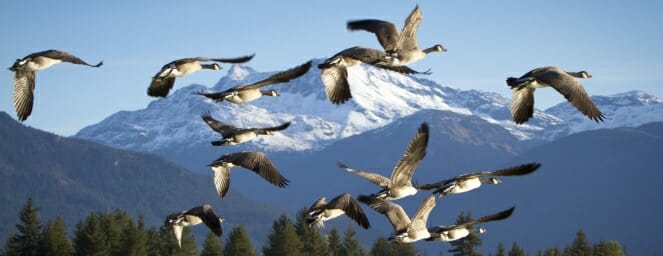
What is the goal of Whistler’s geese management program?
The goal of Whistler’s geese management program is to reduce the impacts from geese on aquatic life, water quality, human health, and habitats. Whistler’s geese population has grown over the last decade.
What are the impacts caused by geese in Whistler?
The overpopulation of geese in Whistler causes economic, environmental and social impacts in Whistler including:
- Water quality issues
- Threats to human health
- Habitat degradation and loss, and threats to aquatic life and wildlife (e.g. fish, beavers, crustaceans, etc.)
- Park and beach closures due to high E. coli levels in water
- Community and visitor dissatisfaction
How has Whistler’s geese population changed?
Canadian Geese have been landing in Whistler during their migratory period for more than 50 years; however, within the last decade, geese have begun residing in Whistler throughout the summer.
More grassed areas now exist in the valley and geese have an easily accessible food source in a place where they are safe from predators.
This has enabled migratory geese to reside in Whistler through the summer, rather than migrating north, and rapidly increase their population.
What is the RMOW doing to address the impacts from the abundant geese population?
The municipality’s geese management program follows Environment Canada and Canadian Wildlife Services best practices and includes:
- Deterrence, including hazing with dogs trained to make geese uncomfortable at parks
- Flagging tape strung between posts and intermittent floating lights to interrupt overnight roosting
- Retractable fencing used on shorelines of Rainbow, Alpha, Lakeside, and Wayside beaches
- Feces clean-up and education
- Egg addling, which began in 2015 for population management. Eight nesting locations were identified and a total of 41 eggs were addled.
- Population monitoring
What does the municipality do for maintenance, clean-up and deterrence?
Municipal staff clean up feces from the docks and beaches at municipal parks daily. In the middle of June 2015, up to 34 kg per day of fecal matter was removed from the grasses and shorelines of Rainbow Park.
Docks have been raised and fences have installed along the waterfront of Whistler’s beaches and docks to deter geese from Whistler’s waterways
Deterrence techniques, including hazing with dogs, are also used to drive the geese from developed landscapes to natural wetlands.
Please contact the RMOW at stewardship@whistler.ca before deterring geese. Several deterrence techniques require a permit.
Will the fences at Whistler’s parks and beaches remain up all summer?
In early spring, the fences are in place all day and night to encourage the geese to migrate north before they nest. Beginning mid-May, the fences will be in place every evening, but will be removed during the day time.
How does the municipality manage the geese population?
The municipality conducts egg addling to manage Whistler’s geese population following the methods outlined by the Humane Society and according to the specified permit terms. The goal is not to eliminate geese, but rather to achieve an acceptable population.
An acceptable target population is a geese population that allows for Whistler’s environment to maintain its diversity and health, does not expose its visitors or residents to high risk fecal contamination levels (defined by Vancouver Coastal Health’s water quality standards), and aims to find a balance between resident and visitor enjoyment of bird aesthetics and public areas.
Prior to addling, eggs are tested to determine the egg’s age. Only eggs in early development are permitted to be addled. The inside of geese eggs in early development look much like chicken eggs that people eat—their appearance is yolk-like.
Eggs are removed from the nest and then cooled. Much like when a chicken egg is removed from the nest, when a goose egg is removed, it stops development. An artificial egg is placed in the nest for every egg removed.
How can residents help?
Residents can help to make Whistler’s geese management program a success by monitoring geese activity in their own backyards, recording geese locations and nesting sites, or volunteering with the dog hazing program or as a kayak volunteer to assist Environmental Technicians.
How can the municipality help if I have geese coming in my yard?
Contact the Environmental Stewardship Department at stewardship@whistler.ca for management options and advice. The municipality can access your property to use population management techniques with your written permission.
How are other municipalities dealing with geese issues?
The Okanagan, Victoria, Vancouver, Parksville and many other communities are also dealing with issues related to geese overpopulation. Some municipalities have begun to cull their populations, because their populations are so large that they are having devasting effects on other wildlife, polluting public beach areas and affecting water quality. The Resort Municipality of Whistler’s geese management plan does not focus on culling. The plan, instead, focuses on maintenance, clean-up, deterrence, education, and moving towards a more acceptable geese population.
Who can I contact for more information or to get involved?
Contact the RMOW’s Environmental Technician at stewardship@whistler.ca.
